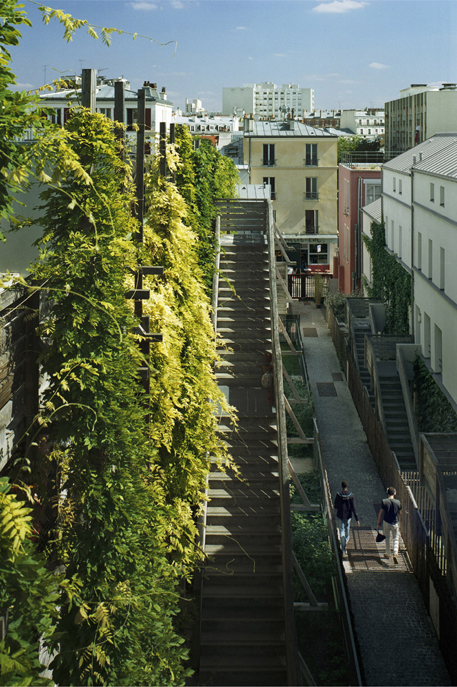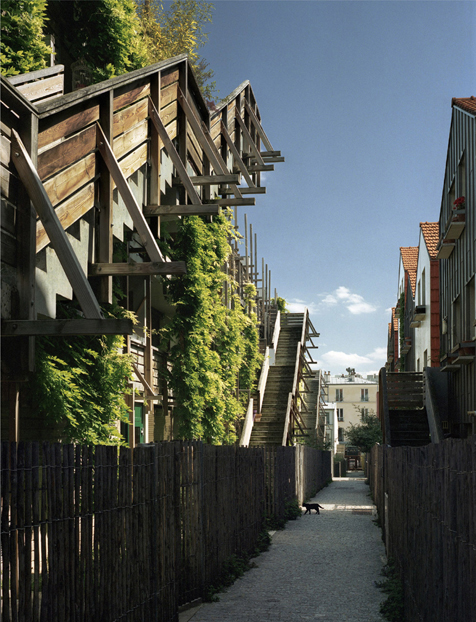4.2
Eden Bio, France
4.2.1 Eden Bio, France

The Project
The site is enclosed by three streets, and was once an orchard and allotments. Paris Habitat, a supplier of social housing in the French capital, held a competition to design social housing in this area. Maison Edouard François (MEF) won with their bisecting and heavily landscaped scheme.
Context
Eden Bio is very close to the famous Père Lachaise cemetery. It is a quiet area (Charonne) with a diverse population – typically Parisian, with boutiques, small cafes and artists’ studios dotted around narrow streets.
‘Greening’ Paris is a very big motive currently: there are proposals to put floating gardens on the Seine to improve the biodiversity of the river’s banks, as well as a plan to double the number of green rooftops in the city by 2020.
Culture
Social housing and its position is a hot topic in Paris. Postwar Brutalist apartment blocks, originally designed as working-class housing on the outskirts of the city, have now become ‘ghettoes’ of poorer families and immigrants, who have been pushed out of central Paris. Parisians refer to these areas as banlieues, which can sometimes be a derogatory term meaning slums dominated by immigrants. Projects such as this one, which are integrating social housing into central Paris, are heavy with political feeling at planning level.1
Vernacular House Type
Inspiration was taken from the local context rather than any particular building type. The surrounding buildings vary in scale: they are sometimes five or six-storey town houses, and sometimes single-storey shops with homes above. They present a complete mix of materials: stone, brick or render, with pitched zinc or tile roofs and the odd flat roof. MEF have experimented with materials in different ways in the development. The roof forms are reminiscent of those on old Parisian dwellings. These differently scaled roofs become partial walls, creating a lovely landscape appreciable at ground and rooftop level. The design concept sought to integrate and create a dialogue with the existing housing. In order for the new development to fit in, new housing in the vernacular style was created simply to bridge the boundary between this development and the existing streets. This is very effective.

4.2.2 Site plan, showing how the scheme integrates into the existing streets.

4.2.3 The scheme in context.
The Design Approach by Edouard François
Maison Edouard François are known for producing projects that integrate landscape and architecture. One of their most famous buildings is ‘L’immeuble qui pousse’ (The Building that Grows) in Montpellier, characterised by its irrigated, porous gabion walls on which sedum, moss and herbs grow freely.
The general design ethos at MEF is to work with the context and to respect it, but not to be influenced by it in a stylistic sense. François thinks that this approach is more ‘vernacular’ than others. However, if they are working in an area with a certain typology, they could be inspired by that vernacular.
The orchard is represented in the design by a central ‘green’ block. The green is provided by wisteria vines, self-seeded plants and green lighting at night. A great deal of money was spent on bringing in enough organic matter to make up 1.5m of soil depth. Then 5cm-tall plants were planted, the rest left to self-seed at will. The impact of the soil quality is shown in the thickness of the vines and the rate at which they have grown in only four years.

4.2.4 Green lighting in the evening.
François’ general philosophy is to design buildings as simply as possible, but spend money on something special that really ‘lifts’ each project. On this scheme, the ‘lifting’ element is the landscaping. The rapid growth of the vines gives the appearance of a much older development than its true age of four years. Two of the periphery houses are designed with the sole purpose of incorporating the whole scheme into the existing urban fabric. The scale of each house is also playful and never monotonous. This means that the entrance, via a greenhouse-type structure, is of a garden scale – a much friendlier arrival than would be provided by, say, a four-storey building. The greenhouse-style building forms an effective bike store and letterbox area. The incorporated landscape and sedum roof terraces would surely have been a hit with the town planners (see ‘Culture’, page 126).
Resident Feedback
INTERVIEWEE DETAILS: three residents, ranging in age from around 15 to 50; all were social-housing tenants. TRANSLATORS: Andrew McClure, architect at MEF (interviews) and Susan Nunneley (texts)
Comfort
All of the residents were very comfortable and they hardly ever have to use the heating, even in winter. One ground-floor apartment was quite dark on a dull day, though it is a nice feature that all the apartments are dual-aspect. Each flat has a balcony and common garden area – and these are often used, according to the residents. When asked if they were ever too hot or too cold, none of the residents said they were. The heating system is shared by all of the apartments, and is controlled by the concierge. Some people were disturbed by others’ behaviour, claiming that some residents threw rubbish out of their windows onto the ground below and littered their own gardens. One resident said that because it is cheaper to live here, people seemed to treat the area badly – there was no respect.
Appropriateness
Despite not deliberately referring to the vernacular, contextual study has created a new vernacular style. Something that all of the residents found appealing and referred to was that ‘it looks like an old house but it works like a modern house’. The insertion of two of the houses into an existing street gives a hint of what is happening in the development between the three streets, and really suits the various different architectural styles visible here. The projecting windowsills for pots, and the window proportions, respectfully ‘talk to’ the Juliet balconies and facade patterns of the existing buildings without diverting attention from them.
Sustainability
It is well known that plants ease stress and that their transpiration reduces temperatures in summer. These are useful tools to provide occupant wellbeing and reduce overheating. Sadly in the UK, landscaping is often the last thing on developers’ minds – usually a token gesture, enforced by planners. Eden Bio’s balconies and gardens were well used by its residents and highly appreciated in urban Paris. Every window has a plant holder, encouraging the occupiers to grow even more. It is also nice to see that despite the development the essence of the original allotment was not forgotten, and that these dwellings have been enhanced by their reference to it.

4.2.5 Landscaping is the element that ‘lifts’ the project.
Improvement
It is refreshing to see a design that appears to have so much fun with social housing. The variety of scale, the cheerful materials that draw on Parisian vernacular, the rhythm of the external staircases and the green interruptions caused by the vines offer a real sense of place. It all fits in with this area of Paris and is a good example of how to integrate social housing within a city centre rather than push it to the outskirts.

4.2.6 Metal-clad facades with projecting windowsills for plant pots.
